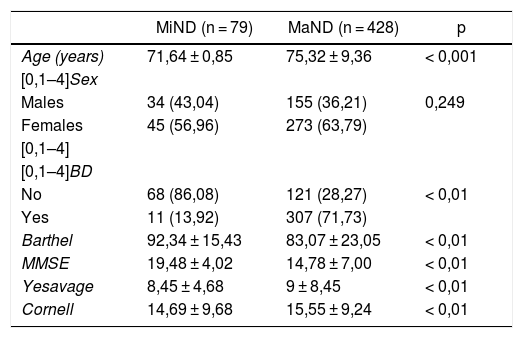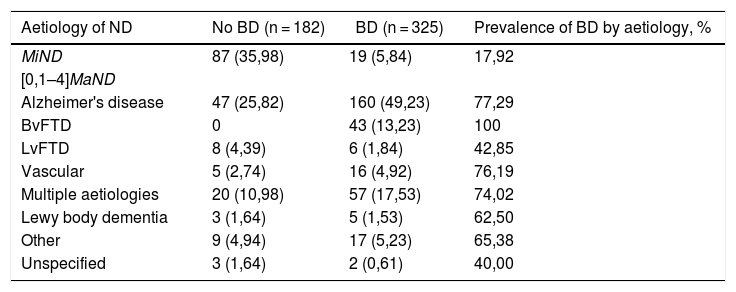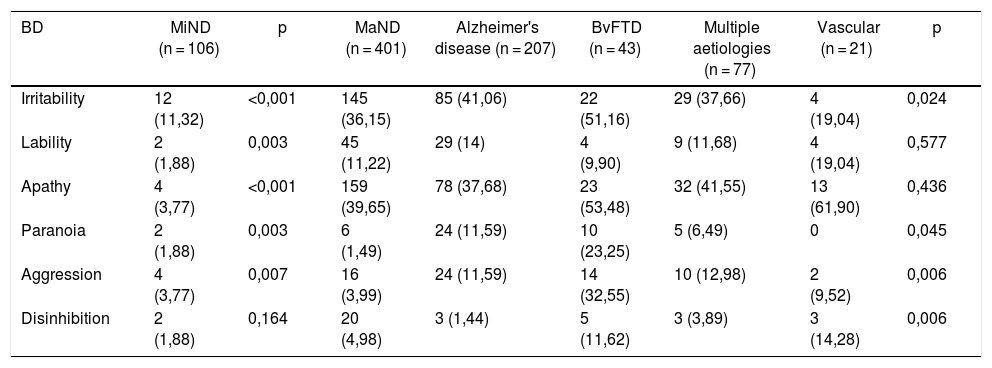The main aim of this study is to determine the prevalence of behavioural disturbances (BD) in a group of patients with diagnosis of neurocognitive disorders assessed by a memory clinic in a referral assessment centre in Bogotá, Colombia, in 2015.
Material and methodsThis is an observational, retrospective descriptive study of 507 patients with a diagnosis of neurocognitive disorder (according to DSM-5 criteria) evaluated in a referral centre in Bogotá, Colombia, in 2015.
ResultsAmong the group of patients assessed, analyses reveal mean age for minor neurocognitive disorders of 71.04 years, and 75.32 years for major neurocognitive disorder (P < 0.001). A total of 62.72% of the sample were female. The most prevalent aetiology of the neurocognitive disorders was Alzheimer’s disease, followed by behavioural variant frontotemporal dementia and neurocognitive disorders due multiple aetiologies. BD occur more frequently in neurocognitive disorder due to behavioural variant frontotemporal dementia (100%), Alzheimer’s disease (77.29%) and vascular disease (76.19%). The most prevalent BD in the group assessed were apathy (50.75%), irritability (48.45%), aggression (16.6%), and emotional lability (14.76%).
ConclusionsBD occur more frequently in patients with diagnosis of major neurocognitive disorder. BD are more prevalent in behavioural variant frontotemporal dementia than any other group. Apathy, irritability, emotional lability and aggression are the BD that occur with greater prevalence in our sample. We discuss the importance of BD in the clinical progression of neurocognitive disorders.
El objetivo de este estudio es determinar la frecuencia de alteraciones conductuales (AC) en un grupo de pacientes con diagnóstico de trastorno neurocognoscitivo (TN) valorado por clínica de memoria en un centro de evaluación en Bogotá, Colombia, durante el año 2015.
Material y métodosEstudio observacional descriptivo y de corte retrospectivo de 507 pacientes con diagnóstico de trastorno neurocognoscitivo (según criterios del DSM-5), valorados en un centro de referencia en Bogotá en 2015.
ResultadosLa media de edad de los sujetos con trastorno neurocognoscitivo leve en el momento del diagnóstico era 71,04 años y la de aquellos con trastorno neurocognoscitivo mayor, 75,32 años (p < 0,001). El 62,72% de la muestra son mujeres. La etiología más frecuente del trastorno neurocognoscitivo fue la enfermedad de Alzheimer probable, seguida por la degeneración lobar frontotemporal, variante conductual, y el trastorno neurocognoscitivo debido a múltiples etiologías. Las AC se presentan con mayor frecuencia en TN debido a degeneración frontotemporal variante conductual (100%), enfermedad de Alzheimer (77,29%) y vascular (76,19%). Las AC más prevalentes en el grupo evaluado fueron la apatía (50,75%), la irritabilidad (48,45%), la agresividad (16,6%) y la labilidad emocional (14,76%).
ConclusionesLas AC suelen aparecer en pacientes con diagnóstico de trastorno neurocognoscitivo mayor. Según la etiología del trastorno neurocognoscitivo mayor, las AC son más prevalentes en la degeneración frontotemporal variante conductual. Apatía, irritabilidad, labilidad emocional y agresividad son las AC más comunes en toda la muestra.









